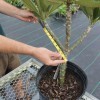Abstract
Plumeria are flowering ornamentals native to the Caribbean, Mexico, Central America, Venezuela, and Colombia. Highly valued for their colorful flowers, plumeria are now grown in tropical and subtropical areas throughout the world. Plumeria, or frangipani, are members of the Apocynaceae family. Unless steps are taken to prevent frost damage, plumeria are generally limited to landscape uses in south Florida and protected regions of central Florida. This 5-page fact sheet was written by Andrew K. Koeser, Gitta Hasing, and Drew McLean, and published by the UF Department of Environmental Horticulture, October 2013.
ENH1228/EP489: Plumeria: Propagation from Cuttings (ufl.edu)
References
Bunch, Alan. 2010. The Exotic Plumeria, The World's Number One Plumeria Catalog.
Chatfield, J. and M. Quigley. 2003. "A Plant by Any Other Name" in Tree Selection and Planting: A Collection of CEU Articles. International Society of Arboriculture, Champaign, IL.
Eggenberger, R. and Eggenberger, M. The Handbook on Plumeria Culture, Fourth Rev. ed. and Expanded. Golden Bridge Publications, 2005.
Florida Department of Environmental Protection. 2010.Florida Friendly Best Management Practices for Protection of Water Resources by the Green Industries. 2nd Edition. State of Florida. http://fyn.ifas.ufl.edu/pdf/GIBMP_Manual_WEB_2_17_11.pdf.
Gupta, M., U. K. Mazumder, P. Gomathi, and V. Thamil Selvan. 2006. Anti-inflammatory Evaluation of Leaves of Plumeria acuminata. BMC Complementary and Alternative Medicine. 6(1):36. https://doi.org/10.1186/1472-6882-6-36
Menninger, Edwin A. Color in the Sky. Horticultural Books, Inc. New York, 1975.
All About Frangipanis All Things Frangipani. Pacific Palms Designs. CSS Design by FCT. Web. 16 August. 2013. http://www.allthingsfrangipani.com/frangipanis.html.
USDA. Plant Hardiness Zone Map Florida. USDA Agricultural Research Service, United States Department of Agriculture. http://planthardiness.ars.usda.gov/PHZMWeb/#.

